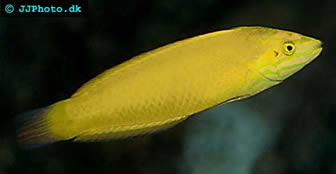Yellow Coris
Halichoeres chrysus
Common name: Yellow Coris, Yellow Wrasse, Canary Wrasse, Golden Rainbowfish, Golden Wrasse
Scientific name: Halichoeres chrysus
Max size: 5 in / 12-.5 cm
pH: 8.1-8.4
Salinity: 1.020-1.025
Temperature: 72-78ºF (22-26°C)
The name Yellow coris is a bit misleading as this fish isn't really a coris species at all; it is a wrasse. For this reason it is in my opinion better to use the names Yellow wrasse or Canary wrasse instead.
This species is bright yellow with an "eye" on the dorsal fin. The tail fin is sometimes blue.
It is very suitable for marine aquariums as it is small, hardy and easy to care for. It can be recommended to beginners who want to start keeping saltwater fish. It is a friendly fish that should only be kept with other friendly species. If it get scared it might burrow itself down into the sand, sometimes they just hide its head.
Whether or not the Yellow coris / wrasse is reef safe is a matter of some debate. Some consider it to be reef safe, other doesn't. The truth seems to vary between different specimens and example of this is that they usually nibble on rock but some specimens seem to nibble at corals as well. It is therefore recommended to keep an eye on your Yellow coris / wrasse to make sure it behaves if you keep it in a reef setup.
The Yellow coris / wrasse originates from the eastern Indian Ocean and the western Pacific Ocean. It can be found from Japan in the north down to Australia in the south. All Yellow coris / wrasses in the trade are collected from the wild.
Yellow coris care and aquarium setup:
The Yellow coris / wrasse should be kept in an aquarium of at least 30 gallon / 120 L. The aquarium should be decorated with a lot of rocks that form caves and other hiding places. The Yellow coris / wrasse likes a lot of light, but there should be shaded areas as well. The aquarium should be well circulated with some calmer areas. The Yellow coris / wrasse appreciates a thick layer of sand in which it can burrow and hide itself when it get scared. It can be kept in "fish only", "fish with live rocks" and reef setups. Just remember that this species aren't always reef safe.
Ideal water conditions are pH 8.1-8.3, salinity 1.020-1.025, and ttemperature: 74-78ºF (23-26°C).
Feeding Yellow coris
The Yellow coris / wrasse is easy to feed and accepts most types of food, including marine flake food. Sometimes they need to be trained before accepting flakes. They should be provided a varied meaty diet. A good diet can be based around flake food that is complemented with frozen food and chopped sea food. Feed them 3 times a day.
Breeding yellow coris
This species have not been bred in aquariums. In the wild, it breeds in harems where one male keeps several females. Perfect conditions and keeping them in a harem is likely required to breed them. Sexing the Yellow coris / wrasse is a bit harder than sexing other wrasses, but females are generally speaking smaller and less colorful. It is hermaphroditic and all (most) fish are born females and then develop into males if there is a shortage of males. Some fish – so called super males – are genetically determined to be males their entire lives.
Wrasse Articles:
Bird Wrasse – Gomphosus varius
Dragon Wrasse - Novaculichthys taeniourus
Harliquin Tuskfish – Coerodon fasciatus
Hogfish - Information about Hogfish
Neon Wrasse – Halichoeres melanurus
Ornate Wrasse – Halichoeres ornatissimus
Queen Coris – Coris frerei
Radient Wrasse – Halichoeres iridis
Spanish Hogfish – Bodianus rufus
Striated Wrasse – Pseudocheilinus evanidus
Line Wrasses:
Fourline Wrasse – Pseudocheilinus tetrataenia
Sixline Wrasse – Pseudocheilinus hexataenia
Eightline Wrasse – Pseudocheilinus octotaenia
Fairy Wrasses:
Exquisite Fairy Wrasse – Cirrhilabrus exquisitus
Lubbock's Fairy Wrasse – Cirrhilabrus lubbocki
Scott's Fairy Wrasse – Cirrhilabrus scottorum
Solar Fairy Wrasse – Cirrhilabrus solorensis
Flasher Wrasses:
Carpenter's Flasher Wrasse – Paracheilinus carpenteri
Dot-and-Dash Flasher Wrasse – Paracheilinus lineopunctatus
Filamented Flasher Wrasse – Paracheilinus filamentosus
McCosker's Flasher Wrasse – Paracheilinus mccoskeri

